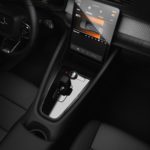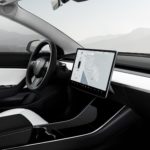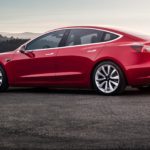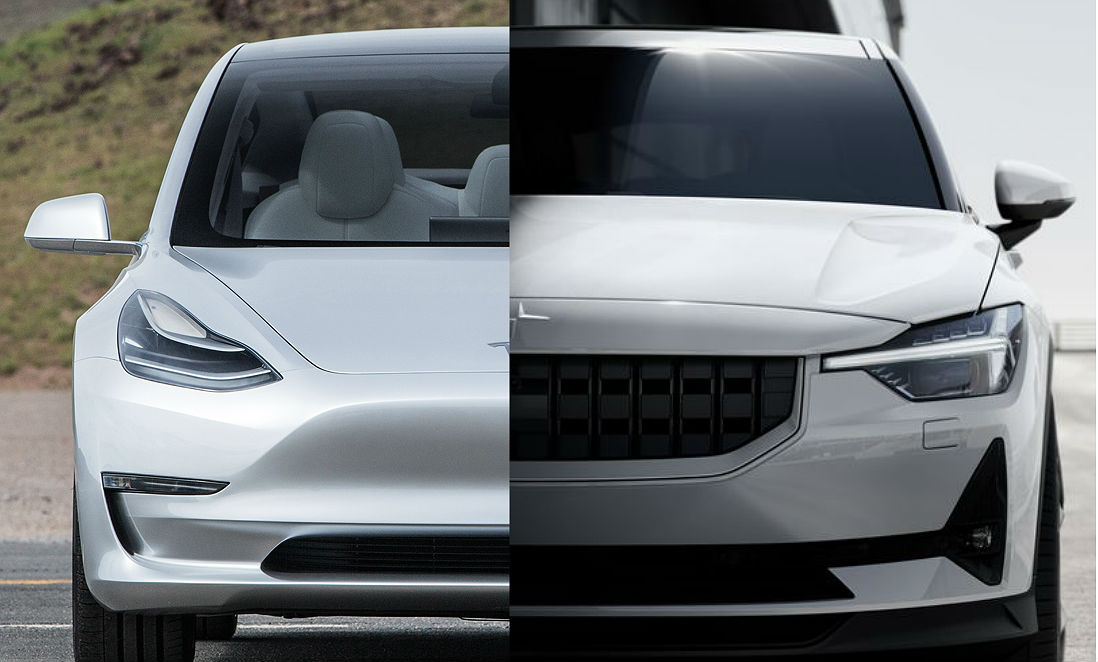
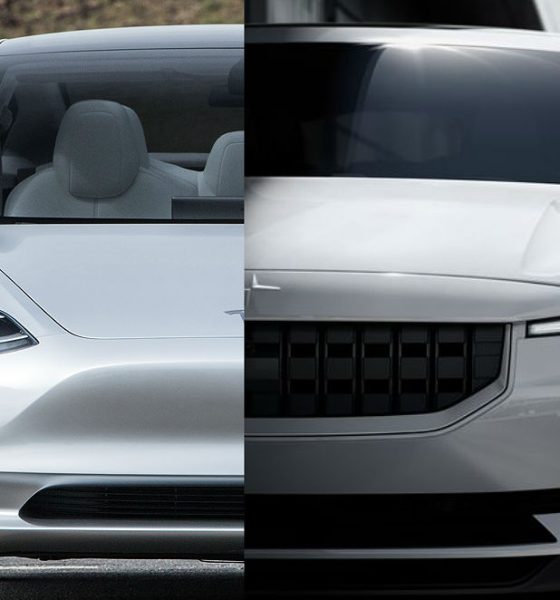
News
Tesla Model 3 vs Polestar 2: performance, features, batteries, and price
Volvo’s Polestar 2, which has been dubbed as a potential competitor to the best-selling Tesla Model 3, was recently unveiled. Here is a comparison of the vehicles in terms of their performance, features, batteries, and price.
Performance and Features
The Polestar 2 is equipped with dual motors that produce 408 hp, which allow the car to go from 0-60 mph in under 5 seconds. It is also an electric vehicle that features a deep integration with Google’s Android ecosystem, with its interior being dominated by an 11″ touchscreen that is loaded to the brim with familiar apps like Google Maps and Google Play Music. The Polestar 2 even has Google Assistant, which is arguably one of the most robust voice assistants in the market today, rivaling Apple’s Siri and Samsung’s Bixby.
The Model 3 features Tesla’s trademark performance and tech. The Model 3 Performance, which is in the same price category as the Polestar 2 Launch Edition (the first version of the car that will enter production), is equipped with dual motors that produce 450 hp, allowing the vehicle to sprint from 0-60 mph in 3.3 seconds. The Model 3 also features Tesla’s custom tech for its electric cars, which include features such as Autopilot. The vehicle also receives regular, free over-the-air software updates, which improve the vehicle and add features such as the recently-released Sentry Mode and Dog Mode.
Batteries and Range
The Polestar 2 is equipped with a sizable 78 kWh battery pack comprised of cells from LG Chem, which the company expects will give the fastback a range of 275 miles per charge. This figure is lower than the estimates of Polestar COO Jonathan Goodman last year, when he mentioned to Autocar at the 2018 Goodwood Festival of Speed that the Polestar 2 will have a range of around 350 miles per charge.
In comparison, the Long Range Tesla Model 3 is equipped with a ~75 kWh battery pack made of cells produced in Tesla’s Gigafactory 1 in Nevada. Despite having a smaller battery than the Polestar 2, the Long Range Model 3 features more range at 310 miles per charge. Tesla’s Mid Range Model 3, which is speculated to be equipped with a 62 kWh battery, features a range of 264 miles per charge.
Price
At a price between $45,000 for the base version and $68,000 for the fully-loaded top-tier variant, the Polestar 2 is a pretty solid option in the electric vehicle market. The Polestar 2 “Launch Edition,” which costs $63,000 and is expected to be produced first, is priced comparably with the Model 3 Performance, providing would-be electric car buyers who do not wish to purchase a Tesla a good alternative.
Tesla has been able to bring the price of the Model 3 down over the past few months. Currently, Tesla sells the vehicle’s most affordable variant, the Mid Range Model 3, for $42,900 before savings. The Long Range Dual Motor AWD Model 3 sells for $49,900 before savings, and the top-tier Model 3 Performance costs $60,900 before savings. Buyers who opt to purchase Enhanced Autopilot can order the driver-assist system for $5,000.
Conclusion
Ultimately, it should be noted that the Polestar 2 is something more than a competitor for the Model 3. It is a well-rounded vehicle produced by an experienced carmaker that is unashamedly electric; and thus, it is more of a threat to gasoline-powered cars than it is to other EVs on the market. With vehicles such as the Model 3 and the Polestar 2, it might be only a matter of time before the era of high-performance sedans such as the BMW M3 and the Mercedes-AMG C 63 S comes to an end.

News
Tesla FSD fleet is nearing 7 billion total miles, including 2.5 billion city miles
As can be seen on Tesla’s official FSD webpage, vehicles equipped with the system have now navigated over 6.99 billion miles.

Tesla’s Full Self-Driving (Supervised) fleet is closing in on almost 7 billion total miles driven, as per data posted by the company on its official FSD webpage.
These figures hint at the massive scale of data fueling Tesla’s rapid FSD improvements, which have been quite notable as of late.
FSD mileage milestones
As can be seen on Tesla’s official FSD webpage, vehicles equipped with the system have now navigated over 6.99 billion miles. Tesla owner and avid FSD tester Whole Mars Catalog also shared a screenshot indicating that from the nearly 7 billion miles traveled by the FSD fleet, more than 2.5 billion miles were driven inside cities.
City miles are particularly valuable for complex urban scenarios like unprotected turns, pedestrian interactions, and traffic lights. This is also the difference-maker for FSD, as only complex solutions, such as Waymo’s self-driving taxis, operate similarly on inner-city streets. And even then, incidents such as the San Francisco blackouts have proven challenging for sensor-rich vehicles like Waymos.
Tesla’s data edge
Tesla has a number of advantages in the autonomous vehicle sector, one of which is the size of its fleet and the number of vehicles training FSD on real-world roads. Tesla’s nearly 7 billion FSD miles then allow the company to roll out updates that make its vehicles behave like they are being driven by experienced drivers, even if they are operating on their own.
So notable are Tesla’s improvements to FSD that NVIDIA Director of Robotics Jim Fan, after experiencing FSD v14, noted that the system is the first AI that passes what he described as a “Physical Turing Test.”
“Despite knowing exactly how robot learning works, I still find it magical watching the steering wheel turn by itself. First it feels surreal, next it becomes routine. Then, like the smartphone, taking it away actively hurts. This is how humanity gets rewired and glued to god-like technologies,” Fan wrote in a post on X.
News
Tesla starts showing how FSD will change lives in Europe
Local officials tested the system on narrow country roads and were impressed by FSD’s smooth, human-like driving, with some calling the service a game-changer for everyday life in areas that are far from urban centers.

Tesla has launched Europe’s first public shuttle service using Full Self-Driving (Supervised) in the rural Eifelkreis Bitburg-Prüm region of Germany, demonstrating how the technology can restore independence and mobility for people who struggle with limited transport options.
Local officials tested the system on narrow country roads and were impressed by FSD’s smooth, human-like driving, with some calling the service a game-changer for everyday life in areas that are far from urban centers.
Officials see real impact on rural residents
Arzfeld Mayor Johannes Kuhl and District Administrator Andreas Kruppert personally tested the Tesla shuttle service. This allowed them to see just how well FSD navigated winding lanes and rural roads confidently. Kruppert said, “Autonomous driving sounds like science fiction to many, but we simply see here that it works totally well in rural regions too.” Kuhl, for his part, also noted that FSD “feels like a very experienced driver.”
The pilot complements the area’s “Citizen Bus” program, which provides on-demand rides for elderly residents who can no longer drive themselves. Tesla Europe shared a video of a demonstration of the service, highlighting how FSD gives people their freedom back, even in places where public transport is not as prevalent.
What the Ministry for Economic Affairs and Transport says
Rhineland-Palatinate’s Minister Daniela Schmitt supported the project, praising the collaboration that made this “first of its kind in Europe” possible. As per the ministry, the rural rollout for the service shows FSD’s potential beyond major cities, and it delivers tangible benefits like grocery runs, doctor visits, and social connections for isolated residents.
“Reliable and flexible mobility is especially vital in rural areas. With the launch of a shuttle service using self-driving vehicles (FSD supervised) by Tesla in the Eifelkreis Bitburg-Prüm, an innovative pilot project is now getting underway that complements local community bus services. It is the first project of its kind in Europe.
“The result is a real gain for rural mobility: greater accessibility, more flexibility and tangible benefits for everyday life. A strong signal for innovation, cooperation and future-oriented mobility beyond urban centers,” the ministry wrote in a LinkedIn post.
News
Tesla China quietly posts Robotaxi-related job listing
Tesla China is currently seeking a Low Voltage Electrical Engineer to work on circuit board design for the company’s autonomous vehicles.

Tesla has posted a new job listing in Shanghai explicitly tied to its Robotaxi program, fueling speculation that the company is preparing to launch its dedicated autonomous ride-hailing service in China.
As noted in the listing, Tesla China is currently seeking a Low Voltage Electrical Engineer to work on circuit board design for the company’s autonomous vehicles.
Robotaxi-specific role
The listing, which was shared on social media platform X by industry watcher @tslaming, suggested that Tesla China is looking to fill the role urgently. The job listing itself specifically mentions that the person hired for the role will be working on the Low Voltage Hardware team, which would design the circuit boards that would serve as the nervous system of the Robotaxi.
Key tasks for the role, as indicated in the job listing, include collaboration with PCB layout, firmware, mechanical, program management, and validation teams, among other responsibilities. The role is based in Shanghai.
China Robotaxi launch
China represents a massive potential market for robotaxis, with its dense urban centers and supportive policies in select cities. Tesla has limited permission to roll out FSD in the country, though despite this, its vehicles have been hailed as among the best in the market when it comes to autonomous features. So far, at least, it appears that China supports Tesla’s FSD and Robotaxi rollout.
This was hinted at in November, when Tesla brought the Cybercab to the 8th China International Import Expo (CIIE) in Shanghai, marking the first time that the autonomous two-seater was brought to the Asia-Pacific region. The vehicle, despite not having a release date in China, received a significant amount of interest among the event’s attendees.
